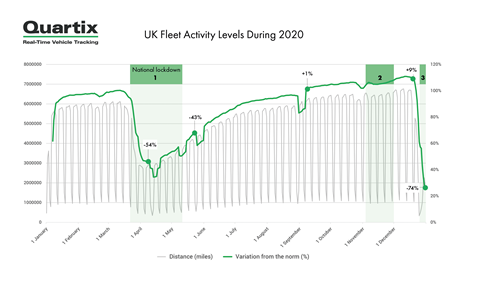
Fleet operators have adapted quickly to the demands of Covid-19 lockdowns, new research from telematics specialist Quartix shows.
Commercial vehicle tracking data shows a major difference in how operators responded to the first, second and third national coronavirus lockdown periods of 2020, the company reported.
While mileage travelled by its UK customers during mid-March to May plummeted by 50%, businesses have adapted to keep activity levels high throughout the following lockdowns.
The statistics were calculated using a date in early March as a point of reference.
Quartix said: “Considering the circumstances of the first lockdown period, it is clear why the pandemic stopped a lot of businesses in their tracks.
“Harsh challenges were posed for many, upturning how businesses could operate and causing many of those operations to cease.
“The second and third national lockdowns show far less impact on business fleet activity - hinting toward successful new ways of working that allowed businesses to continue functioning, while complying with government safety measures. Government guidance was readily available and better understood by this point in time.”
Quartix data shows a steady improvement in fleet activity throughout the summer, with fleet activity hitting normal levels by September 2020.
Early December showed above normal activity levels followed by a steep decline during the Christmas holiday period.
However new data from January 2021 shows activity returning to previous levels within days.
The company added: “As demand for services declined in the spring, many businesses suffered a financial loss. Once restrictions were eased and business could safely resume, it may have encouraged an activity boom.
“Businesses and customers alike were making up for lost time, harbouring a determination to complete work after the recent hiatus.
“The surge of activity in the summer was not only the result of the lifted restrictions, but also people uniting with a will to continue business and drive the economy forward.”













